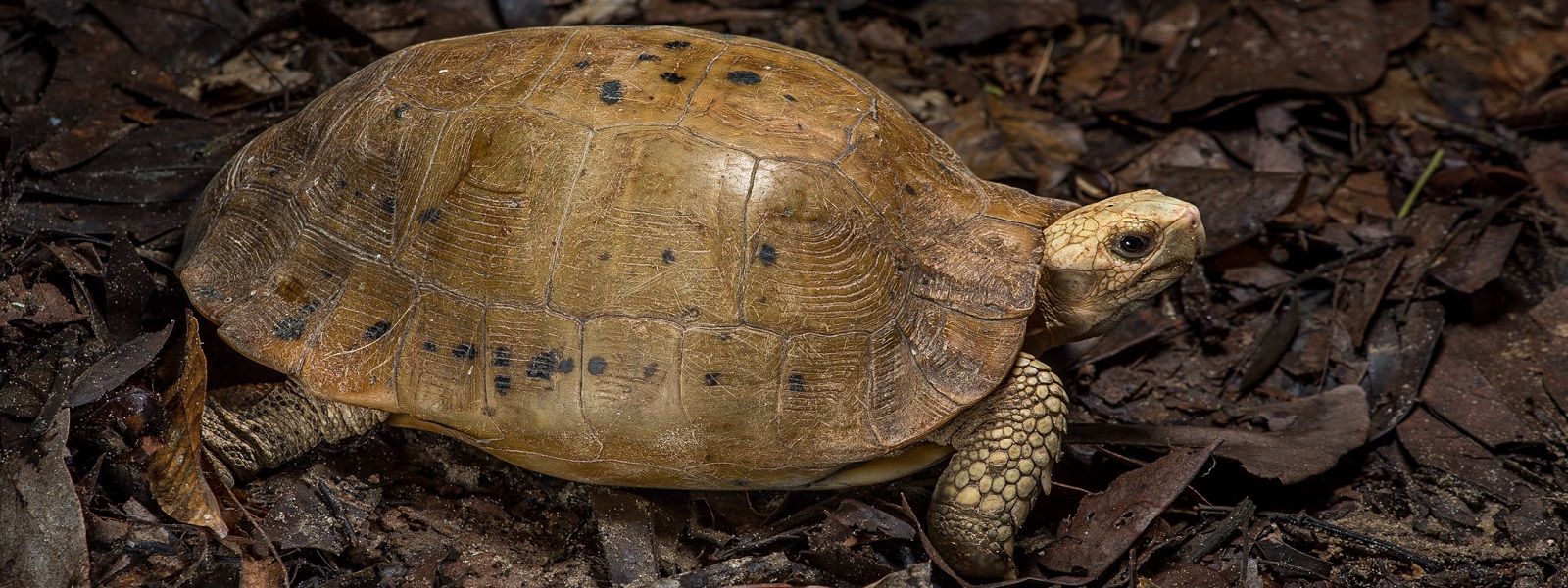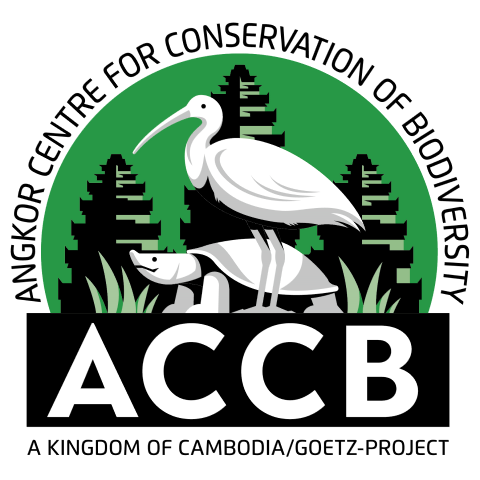Conservation Actions
Indotestudo elongata is included in CITES Appendix II, allowing international commercial trade in the species provided such trade is not detrimental to the species, and subject to national trade legislation. It is also included in Schedule IV of the Indian Wildlife (Protection) Act of 1972 (amended), which lists species that require a small game hunting license to allow collection and local trade; the species may warrant transfer to Schedule I, which would afford stricter protection. In Thailand, the species is protected from exploitation under the WARPA law. Protected under government Decree 32 Group 2B (2006) in Viet Nam. Wildlife conservation act 2010 in Peninsular Malaysia. Wildlife Act 2012 in Bangladesh. It is not effectively protected in Indochina.
Indotestudo elongata has been recorded from many protected areas across its range, including: Lawachara National Park in Bangladesh; Kulen Promtep Wildlife Sanctuary, Central Cardamom Protected Forest, Prey Lang forest, Phnom Nam Lyr Wildlife Sanctuary, and Virachey National Park in Cambodia; Jim Corbett National Park, Rajaji National Park, and Simlipal National Park in India; Nakai Plateau Protected Area in Laos; Shwe Settaw Wildlife Sanctuary; Rakhine Yoma Elephant Reserve, and Natma Taung National Park in Myanmar; Sakaerat Biosphere Reserve and Huai Kha Khaeng Wildlife Sanctuary in Thailand; and Cat Tien National Park in Viet Nam. This species is also suspected to exist in the protected foothill forest in the Transboundary Manas Conservation Area (Ahmed and Das 2010). Although it occurs in many protected areas, there is not always effective protection on the ground.
This species is the focus of conservation projects at the Angkor Centre for Conservation of Biodiversity (ACCB) at Kbal Spean, Cambodia and the Turtle Conservation Centre (TCC) in Cuc Phuong National Park, Vietnam. Work at both ACCB and TCC includes the rehabilitation and captive breeding of tortoises confiscated from illegal trade (Ihlow et al. 2016).
Safeguarding the integrity of large areas of protected areas including corridors (poaching prevention, management of forest fire, boundary protection) throughout the range of the species is probably the single most important factor to ensure the species’ survival. Commercial trade in the species must be restricted to captive-bred animals, and trade must be monitored carefully. Further status surveys are needed.
Location Information
Indotestudo elongata is widely distributed across South and Southeast Asia. The western most limit of the species range is in in Kaleshar Wildlife Sanctuary in the foothills of Himalayas in the Arravali Range. It has localised occurrences in northern and eastern India, Nepal and Bangladesh, Bhutan and much of Myanmar, Thailand and Cambodia, and scattered occurrences in Lao PDR and Viet Nam, and extreme northwestern Peninsular Malaysia (Iverson 1992). Records from PR China (Guangxi) are derived from market animals. In Nepal, Indotestudo elongata is restricted to the terai vegetation zone; much of the terai has been converted to agriculture, and the species is now restricted to terai habitat in Chitwan National Park. A disjunct subpopulation occurs on the Chota Nagpur Plateau in eastern India, which appears to have been isolated from the Himalayan foothills by the alluvial plain and changing environmental conditions after the formation of the Indo-Gangetic Plain (Ilhow et al. 2016). Connectivity across the Brahmaputra is uncertain, as there is potentially a connection from the Himalayan foothills through the Sal forest belt to Orissa.
Geographic Range
Extant
Bangladesh, Bhutan, Cambodia, China, India, Lao People's Democratic Republic, Malaysia, Myanmar, Nepal, Thailand, Viet Nam
Population Information
Despite having a wide distribution, and considerable suitable habitat remaining, severe population declines has occurred recently due to human activities (Ihlow et al. 2016). Scattered available information indicates that the species is depleted and now uncommon to rare throughout its range; survey findings consistently conclude that the species is rare and declining in India and Bangladesh (Moll 1989, Das 1991, Choudhury et al. 2000). A 50-70% decline in population is believed to have occurred in the India/Bangladesh part of the range in the past 20 years (S. Singh pers. comm. 2018). There have been a few reports of Indotestdo elongata individuals in Bhutan's Royal Manus National Park but abundance is low there (Wangyal et al. 2012).
The best subpopulations in Thailand were estimated to have a density of one or a few animals per km2 (Thirakhupt and van Dijk 1995, van Dijk 1998). The sex ratio in this population was also heavily female biased at 1:2.45 (van Dijk 1998). The species is somewhat abundant within protected areas in Thailand, but is collected for consumption outside of protected areas. Habitat destruction has led to a severe reduction in population in northeastast Thailand (M. Cota pers. comm. 2018).
In the latter part of the 20th century I. elongata in Lao PDR and Viet Nam were already scarce and localised (R. Timmins pers comm. 2018). Throughout most of Cambodia and parts of southern Viet Nam, the species was relatively widespread and common. Subpopulations in Lao PDR and Viet Nam and Cambodia have since been severely depleted and possibly locally extirpated. Indotestudo elongata is not uncommon in Myanmar, and subpopulations appear to be relatively stable (K. Platt pers. comm. 2018). In Bangladesh, I. elongata is relatively common in good habitat, but not in areas of habitat degradation (S.C. Rahman pers. comm. 2018). The species' survival is not compatible with human land use (other than responsible tourism in national parks) and will eventually become exclusively restricted to protected areas throughout its range. Overall, a population reduction of 80% is suspected to have occurred over the species range in the past three generations (90 years) as a result of habitat loss and harvest for food.
Threats
The foremost threat to Indotestudo elongata has been the intensive collection almost throughout its entire range for trade to East Asia, starting in 1989 the intensity of which has started to decline only since 2016. The volumes of trade may have appeared to reduced, but investigations into captive farms and legal trade reveal that trade levels for these sources may be higher than reported.
This intensive commercial exploitation came on top of the impacts from long-term (decades to centuries) low-intensity collection for subsistence consumption throughout its range (review in Das 1991, Thirakhupt and van Dijk 1995, van Dijk 1998). In India, I. elongata is associated with Sal forest (Shorea spp); Sal flowers are collected for pharmaceutical purposes, leading to extensive opportunistic collection of tortoises. However, deliberate hunting also occurs, often with the aid of dogs (Pawar and Choudhury 20000; Platt et al. 2007, 2012). The species is collected both for local use and international wildlife trade. In the 1990s I. elongata was considered to be the most common chelonian species in the Vietnamese wildlife trade (Hendrie 1998), and large numbers have been reported in trade in Cambodia (Ihlow and Dawson 2016). Worldwide, a total of at least 918 live specimens, in 20 shipments, were reported as seized from illegal trade during the period 2000-2015 (CITES CoP17 Doc73). The Elongated Tortoise is also available in the international pet trade. However, the impact of trade as pets in minimal compared to the volume of trade for food (Ihlow et al. 2016).
Animals in Nepal, northeast India and Uttar Pradesh, are extensively traded for release at religious institutions; presumably as a result of targeted collection for this purpose.
Habitat impacts have been extensive as deciduous forests have been logged and cleared for settlement with seasonal, dry-land (slash and burn) agriculture; available habitat for the species has shrunk by more than half in the past 50 years in Thailand, and this percentage is probably comparable in other range countries, and even higher rates of habitat loss in Cambodia. Remaining habitat including in managed protected areas is widely impacted by human-associated wildfires, which create very high mortality among juvenile tortoises, to the extent that a population may be reproducing but is barely recruiting (Thirakhupt and van Dijk 1995, van Dijk 1998). This species appears to be absent from areas of dense human population and intensive cultivation (Ihlow et al. 2016).
Other threats to I. elongata are minor and localised in comparison, with reports of decorative masks produced from the carapace available for sale in Nepal, although the species is not particularly favoured for this purpose (Mitchell and Rhodin 1996).
Partners
IUCN Red List Account Link
Please click here to see the species' IUCN Red List Account page.Photo Credits
Scott Trageser/NatureStills LLC









